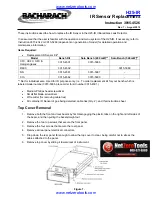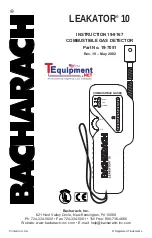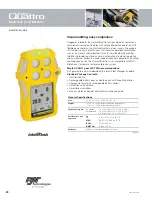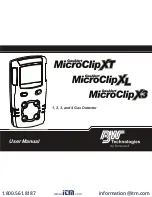
17
ENG
+0300046IE - rel. 1.2 - 14.01.2021
4. CARE & MAINTENANCE
4.1 Maintenance procedure
Periodic maintenance is required on the device to ensure correct
operation. The required maintenance interval varies according to the
type of sensitive element used (semiconductor, electrochemical or
infrared). For details on the maintenance intervals, see the table in
paragraph “5.3 - Sensitive element”.
CAUTION:
maintenance must only be carried out by qualified
personnel.
CAUTION:
gas detectors with a semiconductor sensitive element
must undergo a complete maintenance cycle after exposure to
significant concentrations of refrigerant. Such exposures in fact reduce
sensor life and sensitivity, with the risk of erroneous measurements.
Proceed as follows for maintenance:
1.
Check operation of the LED, buzzer and relay outputs;
2.
Check operation of the analogue output;
3.
Check operation of the RS485 Modbus serial connection, if featured;
4.
Calibrate the sensitive element (zero calibration and full-scale
calibration)
5.
Performing the bump test.
Steps 1 and 2 can be performed from the Test tab in the RILEVA app. See
the corresponding paragraph.
Steps 4 and 5 are described in paragraph “4.2 - Calibration and bump
test”.
Steps 4 and 5 can be skipped when replacing the sensitive element. See
paragraph “4.4 - Sensitive element replacement”.
4.2 Calibration and bump test
4.2.1 Introduction
The gas detector calibration procedure and bump test are mandatory
procedures that must be carried out during both installation and
maintenance (except when replacing the sensitive element). The
calibration and bump test can both be carried out either manually
or using the RILEVA app. Both procedures are described below. The
calibration and bump test require:
•
A calibration kit (available for purchase, part number GDOPZK0000, not
included with the gas detectors) comprising a plastic cap and a rubber
tube;
•
A calibration cylinder, containing the specific type and concentration
of gas for the required application. To purchase this, send an email
to cst@carel.com detailing the required gas and ppm. This service is
currently available in Italy.
1
2
3
4
5
1.
Calibration cylinder
2.
Dispensing valve
3.
Flow regulator
(adjust to around 0.3 l/min)
Calibration kit P/N GDOPZK0000,
comprising:
4.
Transparent rubber tube
5.
Plastic cap
Fig. 4.a
IMPORTANT:
for calibration via the app, it is recommended
to disable the smartphone screen power saving for the duration of
the calibration procedure. This will avoid the risk of calibration being
interrupted and having to repeat the procedure.
CAUTION:
read the following notes carefully before starting the
calibration procedure or bump test.
1.
The gas detector CANNOT have any active alarms or faults during
calibration.
2.
For zero calibration of CO2 sensors, nitrogen (N2) is used as the
reference gas, while for the other sensors ambient air is sufficient.
However, in the latter case, make sure that the ambient air is free
of residual gas concentrations that the sensor is intended to detect
3.
At altitudes above 2,000m, calibration will give a lower reading. In
these applications, the device must be calibrated for the specific
operating environment.
4.
If using a variable flow regulator, adjust the gas flow-rate to
approximately 0.3 l/min.
5.
When starting calibration or a bump test, the device will automatically
go OFFLINE, and will remain so mode until the calibration procedure
or bump test is completed.
6.
For correct operation, always perform the zero calibration first and
then the full-scale calibration. Performing these steps in the wrong
order will cause incorrect calibration.
7.
For correct operation, wait at least two hours after calibration before
operating the device, to ensure complete stabilisation.
8.
The gases used for calibration must NOT be inhaled! Refer to the
corresponding safety data sheets. After use, the gas cylinders must
be discharged into a suitable exhaust hood or outdoors.
Fig. 4.b
4.2.2 Zero calibration
MANUAL
1.
Fit the plastic cap supplied in the calibration kit to the device and
connect the plastic tube to the calibration gas cylinder (or ambient
air, as described in the warning above).
2.
Activate TACT#1 or MAG#1 for > 5 seconds. The LED will flash green-
green-red when the device is ready.
3.
Open the supply of calibration gas (or ambient air, as described
above).
4.
Activate TACT#1 or MAG#1 within 30 seconds of step 1 to confirm
the start of calibration. If not activated, the device will abort the
calibration procedure and return to normal operation.
5.
The LED will start flashing in a green-red, green-red-red, green-red-
red-red sequence, until calibration is complete. To abort calibration,
activate TACT#1 or MAG#1 for > 5 seconds, shut off the gas flow
and remove the calibration kit. If calibration was successful (green
LED), go to step 6. If calibration failed (the LED flashes orange at a
frequency of 2 Hz), activate TACT#1 or MAG#1 once to cancel the
calibration procedure.
6.
Stop the gas flow.
7.
Replace the gas for the zero calibration procedure with the gas for
full-scale calibration and continue the procedure.
Summary of Contents for GDWB
Page 2: ......
Page 4: ...4 ITA 0300046IE rel 1 2 14 01 2021...
Page 6: ......
Page 26: ...26 ITA 0300046IE rel 1 2 14 01 2021 Notes...
Page 28: ...4 ENG 0300046IE rel 1 2 14 01 2021...
Page 30: ......
Page 50: ...26 ENG 0300046IE rel 1 2 14 01 2021 Notes...
Page 51: ......












































